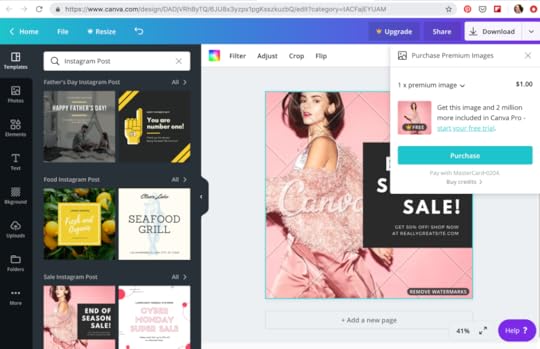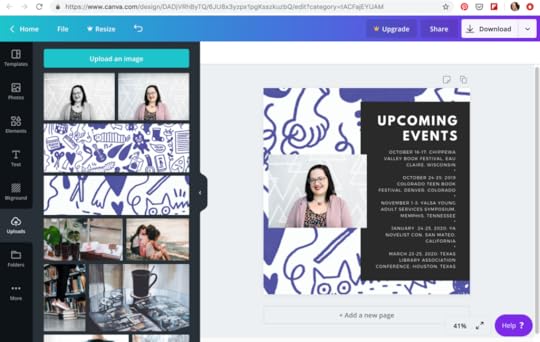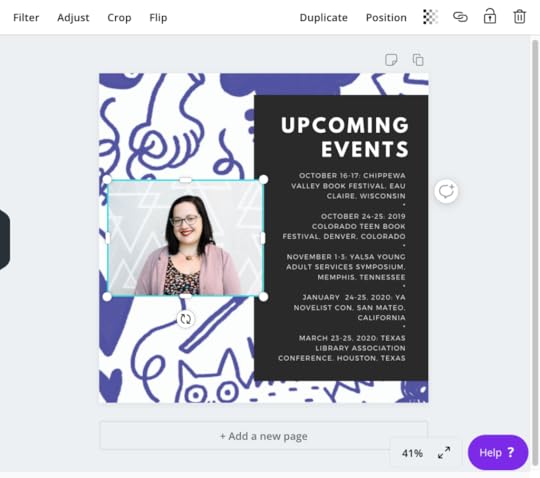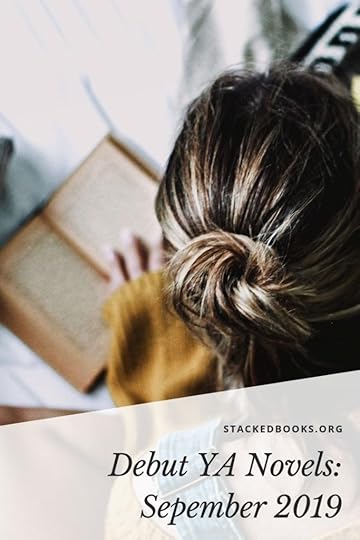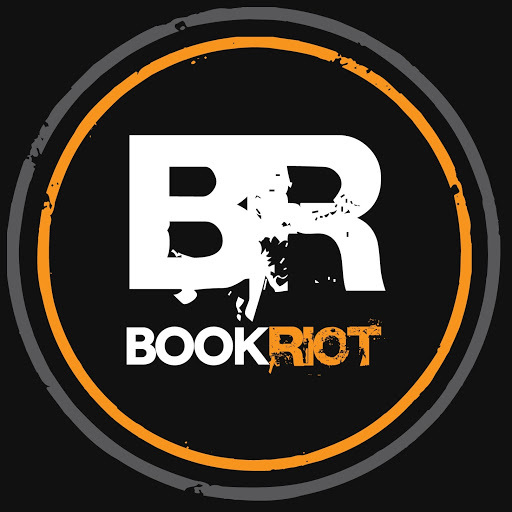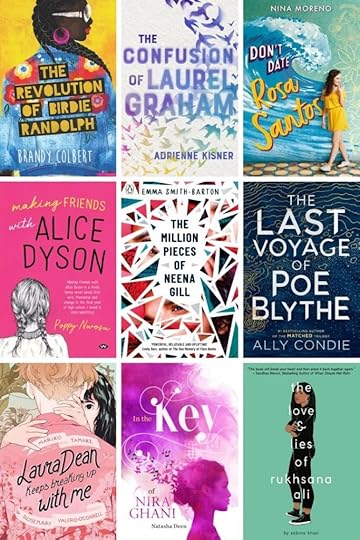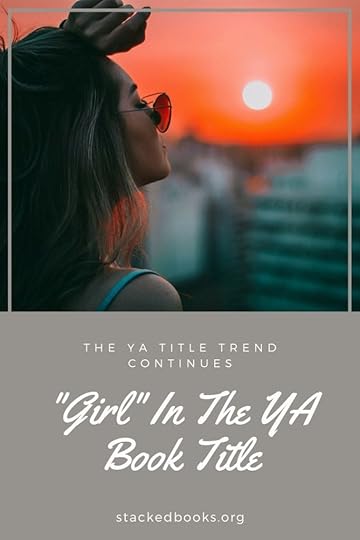Kelly Jensen's Blog, page 26
September 29, 2019
How To Use Canva as an Author, Librarian, or Blogger
The very first page design program I learned was InDesign back in high school, and it was a pain. I learned it for laying out the school newspaper and would need to spend countless hours working on spacing. It wasn’t intuitive at all, but fortunately, through both experience and better development of the software, it got easier to use in college. It’s a super expensive program and out of reach for the average person, but luckily, as that software and others like it evolved, more accessible, similarly-functioning programs emerged. One of those is Canva. I’ve been using it for a long time, and I get asked often how to use Canva. Here’s a quick and dirty basic tutorial for how to use Canva, why you’d want to use it, and how it can be super valuable for authors, librarians, and bloggers alike.
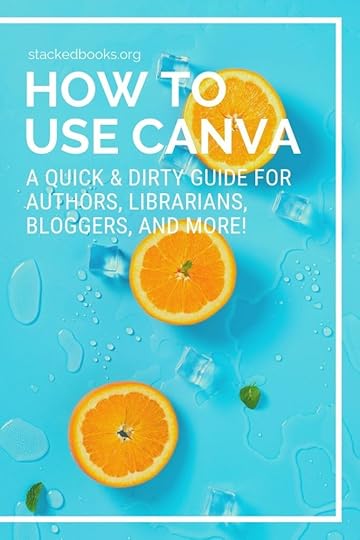
A guide for how to use canva for authors, bloggers, librarians, and more.
graphic design | tutorials | canva tutorial | how to use canva | canva for authors | canva for bloggers | canva for libraries
How To Use Canva As An Author, Librarian, or Blogger
Before diving too deep into this, let me start by noting that this is for those using Canva on a desktop and making use of the non-subscription service. I’ve had a subscription before and found it nice, but it’s absolutely not necessary. You can do virtually everything you’d want to do with the basic, free program. Register as a user so you can have your projects saved.
What Is Canva and Why Use It?
Canva is a graphic design program and it uses “drag and drop” as its design methodology. This means you don’t need to do anything if you don’t want to for design, but there are plenty of functionalities available for those who want to try their hand at designing something fresh. It’s good for both print and digital design — this means for someone like a librarian, it can be great for book lists, signage, or other advertising for programs, and for bloggers and authors, it’s great for making eye-catching graphics to share information.
I use Canva in two primary ways. First, I use it for my work at Book Riot. I’m in charge of maintaining our Pinterest presence, meaning that I choose what to put on Pinterest and optimize for greatest visibility. I also create Pinterest images for Stacked posts with it. My author use for Canva comes in creating graphics that can be used on social media for advertising upcoming events, book deals, and other shareable content. This tutorial will focus on using the Instagram templates, but the same steps are used for creating a Pinterest image, as well as bigger poster projects, infographics, and more.
What makes using Canva’s templates great is that they are optimized for the medium. Pinterest’s best images are 600 pixels wide by 900 pixels tall. You don’t need to know this in order to create the ideal Pinterest image, as Canva has that automatically set for you. The same thing goes with an Instagram image, a Facebook header, and other mediums. This also means when those optimal sizes change, you don’t need to remember. Canva will update the templates.
Templates are regularly updated meaning that you won’t get bored by using the same one or two templates over and over (though, frankly, that’s totally fine too!). You have a lot of flexibility with color choices and layouts, and with a little creativity when it comes to images, sticking to a single template or two can cut down on decision overload.
Sourcing Images
I find pulling together something much easier when I’ve front loaded my work and pulled out some images that I want to use in the design. For anyone with a cohesive brand design, have those files ready to upload. For authors, have your book covers and — hot tip! — if your publisher will let you have the design files from your book cover, use them. I always ask when we have a final cover design for that, and it’s been invaluable in creating promotional stuff.
If you’re starting with nothing, though, there are a couple of excellent places to source free, high-resolution and high-quality stock images. The one I use most frequently is Unsplash. I keep some image collections there of things that catch my eye, often found while searching keywords for other things. If I search “library,” or “reading,” I’ll find what I want for the particular design I’m making but may also save additional images in a collection for later use. You can use these images without attribution or cost.
There are other stock image sites that operate similarly. For images of people of color, try Nappy.co. For images of fat people, use All Go. Broadly offers up a library of images featuring an entire beautiful gender spectrum. Canva has some of its own free images as well, though most are sourced from the above sites.
How To Start Using Canva
Once you’ve signed up and logged in, you’ll see this screen:
You’ll scroll through the “create a design” options for the template you want to use. In my case, it’ll be the Instagram Post. When you select your template, your browser might open a new tab (mine does!) for the design area.
On the left side are the various templates from which you can choose. Since I’m going to be making a schedule of my upcoming book-related events, I want something that’s going to give me some room for text, as well as an image or two. This might be the hardest part of using Canva — you really need to figure out what you need in advance so you save yourself time scrolling because there are a lot of templates to look through.
One thing you’ll see periodically is that a template is not “free.” You’ll know it’s a premium (aka, you have to pay for it) template because the image or design elements will have the Canva watermark on it.
You have a couple of options, though. First, you can, of course, pay for it. If you want to use the template but don’t want to pay for it, though, you can! This is legal. Just delete the image or the graphic design that is watermarked and replace it with your own. You’ll be able to download normally.
Since I think this template is going to work best for my upcoming book event schedule, I’ll begin by deleting that watermarked image and be left with just the text box.
I’ve highlighted the text inside the black box. The text is in two different sizes here: large, which is highlighted, and small, which is just below that. They’re in two separate text boxes. Sometimes, Canva has them “locked.” This means whatever you do with one box will happen with the other (if you move it up or down, to the left or right, all of the locked boxes move together). You can unlock the boxes, though. Where those three dots are above my design, to the right of “spacing,” you’ll see a lock and clicking it will lock or unlock your design. Sometimes, that lock will be right on the bar beside the dots and it serves the same function.
From here, I’ll begin to work on my text. I want the big text to explain what the graphic is for, followed by the smaller text giving the basic details. This will involve a little changing of font size (that’s in the tool bar beside the “A” with a color gradient below it) and also potentially some shifting of alignment of text (that’s beside the italicized “i” in the tool bar).
Though it’s not always the case, this particular template made the black box get longer as my text got longer. If you use a template where it’s not automatically resized, you can click the box and manually adjust the size. You’ll see four white circles around the corners of the box, and you’ll just drag to lengthen and can click again on the box to move it around on the template.
Even when you use a template, you are not married to keeping it exactly as it looked. Rather, you can use it to begin getting creative on your own. If I wanted to move that black box to the left side of the design, I can. I like it on the right, so I’ll leave it there.
The next step is putting a background image into the design. I have the files from my book covers, and while not all of these events are specifically for or about (Don’t) Call Me Crazy, I know that the design will pop with the black box and white text. I’ll begin by uploading the image — the box on the far left side of the page is where I’ll click to begin uploading.
Everything you upload will stay in the upload section, so long as you have an account. This is really convenient if you tend to use the same designs or need the same images over and over.
To get my image over to the background of my template, I’ll drag and drop it. This can take a little finagling, depending on how Canva feels that day. It’s possible you’ll just drop the image in the middle of the template and it stays small. It’s also possible you need to delete it from your design and try again. Eventually, it will stick.
If your image is longer than the design, you can scoot it around, as I did below.
Voila! I could be happy leaving this exactly like it is and call it a day. But, I also know that for book events, having my face on the image can be super helpful for those who don’t know what I look like and want to make a connection between the me they know online and the me they see in person. So I’m going to upload a headshot here, and I’m going to center it on the left side.
Even though there’s not a specific image box there — some templates will have those — I can still add anything I want. I will be given guides, too, to tell me when I have an image centered.
I couldn’t decide whether I liked the color or black and white photo better. My headshot has a cool designed canvas behind it, and that design competes a bit with the background of the project I’m working on in Canva. It’s not ideal to my eye, but it looks better in color than in black and white.
I like the photo laying on top of the black box, but if I wanted to, I could send the photo behind it, so that the edge of my photo is behind the date box.
To reposition anything on my design, I just need to click on it, and this tool bar pops up. From left to right: you can filter your images, making them any variety of colors or gradients. You can adjust the size of the image with the adjust tool (I find using the corners easier, but you might not!). You can crop your images, and if you want to flip your images, you can do that, too. The duplicate tool does exactly what it says, while that position tool allows you to move an image forward or backward on the canvas. This is what I’d click to send my head shot behind the black box. Note: if you have an image on your canvas and play with position and it disappears, it might be hidden behind other images.
The gradient image you see will allow you to highlight or desaturate the selected image. The link will allow you to link that image (I’ve never used this tool before). The lock was explained above — and if I wanted to, since I am happy with this design, I could click all of the elements and lock them into place now. I don’t tend to do that since I don’t do heavy designing or font work, but if you do or want to try it, lock what you know you don’t want to lose in your design.
Saving Your Canva Project
Your projects will automatically save as you make adjustments. But when you come to the end of your project and you’re happy, you have a few options for what to do with the thing you’ve made.
You can simply download the image and select what kind of file type you prefer. You can also upload the image to a presentation, send it to a Facebook group or page, or share it to Twitter or email. There are options to send it to your Pinterest account, too.
I downloaded my image, saved it on my desktop, and am on my merry way.
Other Tips and Tricks
A few additional tools you might want to play with in Canva will give you a chance to explore more images, more design elements, and other fun ways to spice up your graphics.
As you’ll see on the left-hand size, you have an additional toolbar. From top to bottom, you have you templates (in the event you start designing one and want to try a different one!). Then you have photos, which allows you to search both images and clip art. You can search the ones that are free, as well as the ones that are premium, and you’ll know which is which easily.
Elements, the next option, allows you to add some pizazz to your design. You can add circles or squares or other shapes, among other things. Text, as you might imagine, lets you add all kinds of text options to your design, and background gives you some pre-made images you can use as a background anywhere you’d like. There are a lot of great ones.
Your tool bar, as seen above, that lies above your work in progress, has options for changing your font colors, your fonts, and more. Any elements you add to the canvas, such as a box or a shape, you can change the color and gradients of as well.
Since this is a basic tutorial for how to use Canva, I’m not going to dig in much more — rather, I invite you to play around and see how you can use this free program for your own graphic design needs. It’s made for those without knowledge of design at all, and it’s equally useful for those who do this on the regular.
September 24, 2019
Fireborne by Rosaria Munda
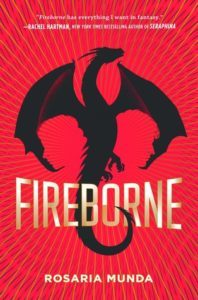 Are you familiar with the concept of a book hangover? You read a book so good that after you finish, you have trouble getting through any other book, because nothing can compare. Fireborne gave me just such a book hangover. Since I finished reading it, I’ve read a chapter or two of five other books and have found myself putting them down and instead ruminating on Fireborne some more and wondering when the sequel will be out (sometime in 2020, I suppose). It’s the kind of book that reminds me why I love reading so much. It is that good.
Are you familiar with the concept of a book hangover? You read a book so good that after you finish, you have trouble getting through any other book, because nothing can compare. Fireborne gave me just such a book hangover. Since I finished reading it, I’ve read a chapter or two of five other books and have found myself putting them down and instead ruminating on Fireborne some more and wondering when the sequel will be out (sometime in 2020, I suppose). It’s the kind of book that reminds me why I love reading so much. It is that good.
In a previous life, before the revolution that toppled the ruling Triarchs and instituted a more equitable society where anyone – not just the nobility – could be chosen by a dragon and rise in society, Annie was a serf. Her family worked the land for a Triarch, one of the three rulers of the land who commanded great fire-breathing dragons. If serf families didn’t have enough of a harvest to tithe, they were punished. After a famine wipes out Annie’s family’s crops, the Triarch makes an example of them: he has his dragon burn them alive and makes six year old Annie watch.
Lee is the son of a ruling Triarch, a man who was murdered in his palace during the revolution, along with the rest of Lee’s siblings. Like Annie, child Lee watched it happen. He was almost murdered too, but the Protector – the leader of the Revolution – discovered what was happening and stopped it at the last moment. He quickly forgot about Lee, who was taken to an orphanage and from then on kept his true identity secret, for fear he would be executed if discovered.
Both children met at the same orphanage and grew close, having experienced similar traumas. Annie is the only one who knows who Lee really is, though neither has ever said it outright. They are now teenagers, chosen by dragons and in training to serve as Guardians, dragonriders who protect their nascent country of Callipolis. On the horizon are a series of battles that will determine who will be Firstrider – leader of the dragon fleet and likely next Protector. But this is not a book about a flying and fighting competition, though that aspect is certainly thrilling. Or rather, it’s not only about that. War is on the horizon – the ousted Triarchs may be dead, but some of their families made it out alive – and that fact will put strain on the baby country, with its high ideals and their imperfect implementation.
This is such a fun book. I’m writing about how fun it is first, because I want to emphasize that part of what makes this book so good is because it is a joy to read. It’s almost unbearably suspenseful at times. It had me racing through the pages, reading faster and faster at certain points so I could know what happened, but not wanting to read ahead because I might miss something equally important in the sections I skipped over. Munda is a top-notch plotter, and I was amazed and impressed by how the story twisted and turned but never felt anything less than authentic and genuinely motivated by her characters and their situations.
Munda’s world-building is fascinating and completely immersive. It’s some of the best fantasy world-building I’ve read in years, the kind that makes you sink into it and absorb it without even trying, without the need to backtrack and take notes and look at family trees and maps on endpapers (though don’t get me wrong, I love those kinds of things). I felt like I was living and breathing Callipolis. And despite the surface similarities to other dragon books, most notably in my experience Anne McCaffrey’s Dragonriders of Pern, Munda’s dragons and her dragonriders feel fresh. They have different magical rules and an interesting culture as backdrop. She introduces the concepts of sparking and spilling over, both of which are completely new to me and help define this living, breathing world. (You’ll have to read the book to learn what they mean!)
And then there’s the deep stuff. Munda writes in her author’s note that she was inspired in large part by Plato’s Republic, which I have not read, but also by the concept in general of what happens after a revolution. Teens in young adult fiction often help to start revolutions, but what happens when the revolution is over? What happens when the revolutionaries have won and they have to turn their efforts to building a new, better government? Shades of the French and Russian revolutions and their subsequent aftermaths tinge her book, though there’s no direct parallel (so you can’t really look to history to guess what’s going to happen next). Munda unpacks all the possible problems that could arise, from the seemingly small (leftover prejudice against lower classes), to the potentially huge (family members of slaughtered rulers wanting revenge), to the most earth-shattering of all (what if the new regime isn’t any better than the old?).
Annie and Lee face really hard choices – and they don’t always make the right ones. Lee in particular is torn between loyalty to his family (and the visceral memory of what was done to them) and loyalty to a new way of life that he now mostly believes in. Annie has her own struggles, including an equally vivid memory of an atrocity committed upon her family. The choices these two teenagers must make in the midst of an impossible situation literally made me gasp out loud at a few points. And each choice leads to another, which leads to another, each more heartrending than the last. You will read this book with your heart in your throat.
All of the pieces of a really great fantasy come together in Fireborne: complex characters, interesting plot, vivid world-building, thorny themes, and elegant writing. And Munda makes it all seem effortless. I got lost in this book; I hope you will too.
I received an advance reader copy from the publisher. Fireborne publishes October 15.
September 22, 2019
Debut YA Novels: September 2019
It’s here! It’s here! Get your September debut YA novels here!
This round-up includes debut novels, where “debut” is in its purest definition. These are first-time books by first-time authors. I’m not including books by authors who are using or have used a pseudonym in the past or those who have written in other categories (adult, middle grade, etc.) in the past. Authors who have self-published are not included here either.
All descriptions are from Amazon, unless otherwise noted. If I’m missing any debuts that came out in September from traditional publishers — and I should clarify that indie/small presses are okay — let me know in the comments.
As always, not all noted titles included here are necessarily endorsements for those titles. List is arranged alphabetically by title, with publication dates in parentheses. Starred titles are the beginning of a new series.
September 2019 Debut YA Novels
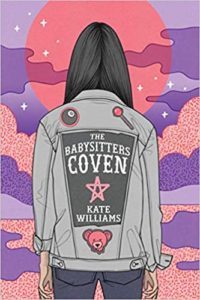 *The Babysitter’s Coven by Kate M. Williams (9/17)
*The Babysitter’s Coven by Kate M. Williams (9/17)Adventures in Babysitting meets Buffy the Vampire Slayer in this funny, action-packed novel about a coven of witchy babysitters who realize their calling to protect the innocent and save the world from an onslaught of evil.
Seventeen-year-old Esme Pearl has a babysitters club. She knows it’s kinda lame, but what else is she supposed to do? Get a job? Gross. Besides, Esme likes babysitting, and she’s good at it.
And lately Esme needs all the cash she can get, because it seems like destruction follows her wherever she goes. Let’s just say she owes some people a new tree.
Enter Cassandra Heaven. She’s Instagram-model hot, dresses like she found her clothes in a dumpster, and has a rebellious streak as gnarly as the cafeteria cooking. So why is Cassandra willing to do anything, even take on a potty-training two-year-old, to join Esme’s babysitters club?
The answer lies in a mysterious note Cassandra’s mother left her: “Find the babysitters. Love, Mom.”
Turns out, Esme and Cassandra have more in common than they think, and they’re about to discover what being a babysitter really means: a heroic lineage of superpowers, magic rituals, and saving the innocent from seriously terrifying evil. And all before the parents get home.
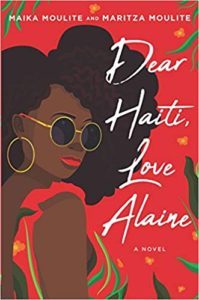 Dear Haiti, With Love by Maika Moulite and Maritza Moulite (9/3)
Dear Haiti, With Love by Maika Moulite and Maritza Moulite (9/3)When a school presentation goes very wrong, Alaine Beauparlant finds herself suspended, shipped off to Haiti and writing the report of a lifetime…
You might ask the obvious question: What do I, a seventeen-year-old Haitian American from Miami with way too little life experience, have to say about anything?
Actually, a lot.
Thanks to “the incident” (don’t ask), I’m spending the next two months doing what my school is calling a “spring volunteer immersion project.” It’s definitely no vacation. I’m toiling away under the ever-watchful eyes of Tati Estelle at her new nonprofit. And my lean-in queen of a mother is even here to make sure I do things right. Or she might just be lying low to dodge the media sharks after a much more public incident of her own…and to hide a rather devastating secret.
All things considered, there are some pretty nice perks…like flirting with Tati’s distractingly cute intern, getting actual face time with my mom and experiencing Haiti for the first time. I’m even exploring my family’s history—which happens to be loaded with betrayals, superstitions and possibly even a family curse.
You know, typical drama. But it’s nothing I can’t handle.
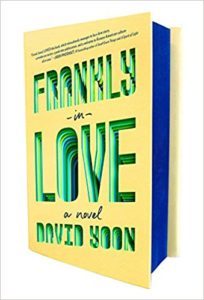 Frankly In Love by David Yoon (9/10)
Frankly In Love by David Yoon (9/10)Two friends. One fake dating scheme. What could possibly go wrong?
Frank Li has two names. There’s Frank Li, his American name. Then there’s Sung-Min Li, his Korean name. No one uses his Korean name, not even his parents. Frank barely speaks any Korean. He was born and raised in Southern California.
Even so, his parents still expect him to end up with a nice Korean girl–which is a problem, since Frank is finally dating the girl of his dreams: Brit Means. Brit, who is funny and nerdy just like him. Brit, who makes him laugh like no one else. Brit . . . who is white.
As Frank falls in love for the very first time, he’s forced to confront the fact that while his parents sacrificed everything to raise him in the land of opportunity, their traditional expectations don’t leave a lot of room for him to be a regular American teen. Desperate to be with Brit without his parents finding out, Frank turns to family friend Joy Song, who is in a similar bind. Together, they come up with a plan to help each other and keep their parents off their backs. Frank thinks he’s found the solution to all his problems, but when life throws him a curveball, he’s left wondering whether he ever really knew anything about love—or himself—at all.
In this moving debut novel—featuring striking blue stained edges and beautiful original endpaper art by the author—David Yoon takes on the question of who am I? with a result that is humorous, heartfelt, and ultimately unforgettable.
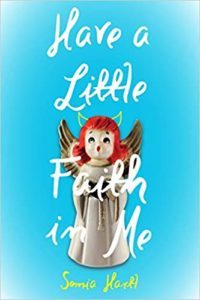 Have A Little Faith In Me by Sonia Hartl (9/3)
Have A Little Faith In Me by Sonia Hartl (9/3)“Saved!” meets To All the Boys I’ve Loved Before in this laugh-out-loud romantic comedy that takes a meaningful look at consent and what it means to give it.
When CeCe’s born-again ex-boyfriend dumps her after they have sex, she follows him to Jesus camp in order to win him back. Problem: She knows nothing about Jesus. But her best friend Paul does. He accompanies CeCe to camp, and the plan―God’s or CeCe’s―goes immediately awry when her ex shows up with a new girlfriend, a True Believer at that.
Scrambling to save face, CeCe ropes Paul into faking a relationship. But as deceptions stack up, she questions whether her ex is really the nice guy he seemed. And what about her strange new feelings for Paul―is this love, lust, or an illusion born of heartbreak? To figure it out, she’ll have to confront the reasons she chased her ex to camp in the first place, including the truth about the night she lost her virginity.
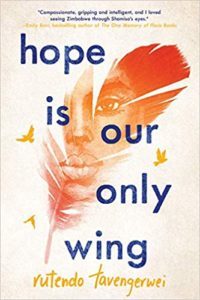 Hope Is Our Only Wing by Rutendo Tavengerwei (9/10)
Hope Is Our Only Wing by Rutendo Tavengerwei (9/10)Set in Zimbabwe, Rutendo Tavengerwei’s unforgettable novel offers a beautiful and honest look at adolescence, friendship, and the capacity for courage.
For fifteen-year-old Shamiso, hope is nothing but a leap into darkness. Grief-stricken and confused after her father’s mysterious death in a car crash, Shamiso moves with her mother from England to Zimbabwe in order to pick up the pieces—returning to an extended family and a world she hardly remembers. For Tanyaradzwa, a classmate whose life has been turned upside down by a cancer diagnosis, hope is the only reason to keep fighting.
As an unexpected friendship blossoms between them and the two girls navigate the increasingly uncertain political situation in Zimbabwe, Tanyaradzwa helps Shamiso confront her fear of loss. In opening herself to someone with a potentially fatal illness, Shamiso knows that she might be opening herself to more pain. Yet Tanyaradzwa is the only one who gives her the strength to ask the burning question: What really happened to her father?
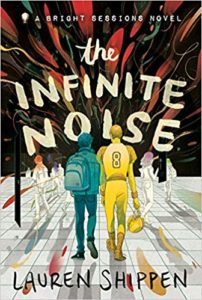 *The Infinite Noise by Lauren Shippen (9/24)
*The Infinite Noise by Lauren Shippen (9/24)Lauren Shippen’s The Infinite Noise is a stunning, original debut novel based on her wildly popular and award-winning podcast The Bright Sessions.
Caleb Michaels is a sixteen-year-old champion running back. Other than that his life is pretty normal. But when Caleb starts experiencing mood swings that are out of the ordinary for even a teenager, his life moves beyond “typical.”
Caleb is an Atypical, an individual with enhanced abilities. Which sounds pretty cool except Caleb’s ability is extreme empathy―he feels the emotions of everyone around him. Being an empath in high school would be hard enough, but Caleb’s life becomes even more complicated when he keeps getting pulled into the emotional orbit of one of his classmates, Adam. Adam’s feelings are big and all-consuming, but they fit together with Caleb’s feelings in a way that he can’t quite understand.
Caleb’s therapist, Dr. Bright, encourages Caleb to explore this connection by befriending Adam. As he and Adam grow closer, Caleb learns more about his ability, himself, his therapist―who seems to know a lot more than she lets on―and just how dangerous being an Atypical can be.
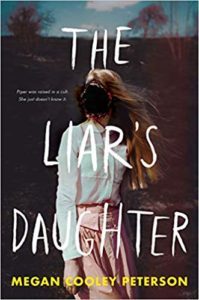 The Liar’s Daughter by Megan Cooley Peterson (9/10)
The Liar’s Daughter by Megan Cooley Peterson (9/10)
Piper was raised in a cult.
She just doesn’t know it.
Seventeen-year-old Piper knows that Father is a Prophet. Infallible. The chosen one.
She would do anything for Father. That’s why she takes care of all her little sisters. That’s why she runs end-of-the-world drills. That’s why she never asks questions. Because Father knows best.
Until the day he doesn’t. Until the day the government raids the compound and separates Piper from her siblings, from Mother, from the Aunts, from all of Father’s followers–even from Caspian, the boy she loves.
Now Piper is living Outside. Among Them.
With a woman They claim is her real mother–a woman They say Father stole her from.
But Piper knows better. And Piper is going to escape.
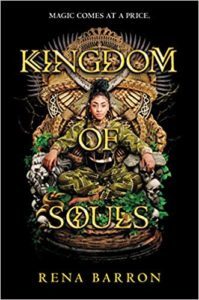 Kingdom of Souls by Rena Barron (9/3)
Kingdom of Souls by Rena Barron (9/3)The lush world building of Children of Blood and Bone meets the sweeping scale of Strange the Dreamer in this captivating epic YA fantasy debut.
Born into a family of powerful witchdoctors, Arrah yearns for magic of her own. But each year she fails to call forth her ancestral powers, while her ambitious mother watches with growing disapproval.
There’s only one thing Arrah hasn’t tried, a deadly last resort: trading years of her own life for scraps of magic. Until the Kingdom’s children begin to disappear, and Arrah is desperate to find the culprit.
She uncovers something worse. The long-imprisoned Demon King is stirring. And if he rises, his hunger for souls will bring the world to its knees… unless Arrah pays the price for the magic to stop him.
Inspired by tales of folk magic in her own community, Rena Barron spins a darkly magical tale perfect for fans of Three Dark Crowns or Shadow and Bone , about a girl caught between gods, monsters, and her own mother’s schemes.
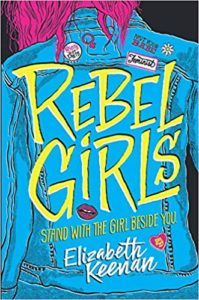 Rebel Girls by Elizabeth Keenan (9/10)
Rebel Girls by Elizabeth Keenan (9/10)When it comes to being social, Athena Graves is far more comfortable creating a mixtape playlist than she is talking to cute boys—or anyone, for that matter. Plus her staunchly feminist views and love of punk rock aren’t exactly mainstream at St. Ann’s, her conservative Catholic high school.
Then a malicious rumor starts spreading through the halls…a rumor that her popular, pretty, pro-life sister had an abortion over the summer. A rumor that has the power to not only hurt Helen, but possibly see her expelled.
Despite their wildly contrasting views, Athena, Helen, and their friends must find a way to convince the student body and the administration that it doesn’t matter what Helen did or didn’t do…even if their riot grrrl protests result in the expulsion of their entire rebel girl gang.
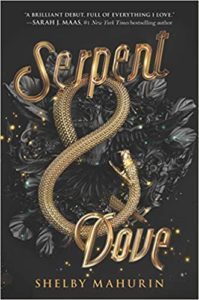 Serpent and Dove by Shelby Mahurin (9/3)
Serpent and Dove by Shelby Mahurin (9/3)Bound as one, to love, honor, or burn. Book one of a stunning fantasy duology, this tale of witchcraft and forbidden love is perfect for fans of Kendare Blake and Sara Holland.
Two years ago, Louise le Blanc fled her coven and took shelter in the city of Cesarine, forsaking all magic and living off whatever she could steal. There, witches like Lou are hunted. They are feared. And they are burned.
As a huntsman of the Church, Reid Diggory has lived his life by one principle: Thou shalt not suffer a witch to live. But when Lou pulls a wicked stunt, the two are forced into an impossible situation—marriage.
Lou, unable to ignore her growing feelings, yet powerless to change what she is, must make a choice. And love makes fools of us all.
Set in a world of powerful women, dark magic, and off-the-charts romance, book one of this stunning fantasy duology will leave readers burning for more.
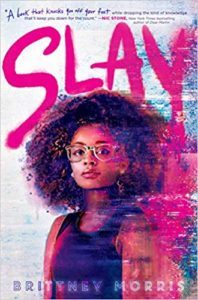 Slay by Brittney Morris (9/24)
Slay by Brittney Morris (9/24)Ready Player One meets The Hate U Give in this dynamite debut novel that follows a fierce teen game developer as she battles a real-life troll intent on ruining the Black Panther–inspired video game she created and the safe community it represents for Black gamers.
By day, seventeen-year-old Kiera Johnson is an honors student, a math tutor, and one of the only Black kids at Jefferson Academy. But at home, she joins hundreds of thousands of Black gamers who duel worldwide as Nubian personas in the secret multiplayer online role-playing card game, SLAY. No one knows Kiera is the game developer, not her friends, her family, not even her boyfriend, Malcolm, who believes video games are partially responsible for the “downfall of the Black man.”
But when a teen in Kansas City is murdered over a dispute in the SLAY world, news of the game reaches mainstream media, and SLAY is labeled a racist, exclusionist, violent hub for thugs and criminals. Even worse, an anonymous troll infiltrates the game, threatening to sue Kiera for “anti-white discrimination.”
Driven to save the only world in which she can be herself, Kiera must preserve her secret identity and harness what it means to be unapologetically Black in a world intimidated by Blackness. But can she protect her game without losing herself in the process?
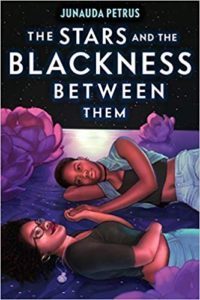 The Stars and the Blackness Between Them by Junauda Petrus (9/17)
The Stars and the Blackness Between Them by Junauda Petrus (9/17)Told in two distinct and irresistible voices, Junauda Petrus’s bold and lyrical debut is the story of two black girls from very different backgrounds finding love and happiness in a world that seems determined to deny them both.
Trinidad. Sixteen-year-old Audre is despondent, having just found out she’s going to be sent to live in America with her father because her strictly religious mother caught her with her secret girlfriend, the pastor’s daughter. Audre’s grandmother Queenie (a former dancer who drives a white convertible Cadillac and who has a few secrets of her own) tries to reassure her granddaughter that she won’t lose her roots, not even in some place called Minneapolis. “America have dey spirits too, believe me,” she tells Audre.
Minneapolis. Sixteen-year-old Mabel is lying on her bed, staring at the ceiling and trying to figure out why she feels the way she feels–about her ex Terrell, about her girl Jada and that moment they had in the woods, and about the vague feeling of illness that’s plagued her all summer. Mabel’s reverie is cut short when her father announces that his best friend and his just-arrived-from-Trinidad daughter are coming for dinner.
Mabel quickly falls hard for Audre and is determined to take care of her as she tries to navigate an American high school. But their romance takes a turn when test results reveal exactly why Mabel has been feeling low-key sick all summer and suddenly it’s Audre who is caring for Mabel as she faces a deeply uncertain future.
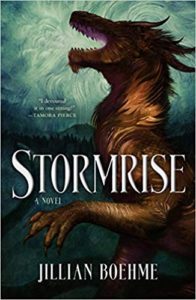 Stormrise by Jillian Boehme (9/10)
Stormrise by Jillian Boehme (9/10)If Rain weren’t a girl, she would be respected as a Neshu combat master. Instead, her gender dooms her to a colorless future. When an army of nomads invades her kingdom, and a draft forces every household to send one man to fight, Rain takes her chance to seize the life she wants.
Knowing she’ll be killed if she’s discovered, Rain purchases powder made from dragon magic that enables her to disguise herself as a boy. Then she hurries to the war camps, where she excels in her training―and wrestles with the voice that has taken shape inside her head. The voice of a dragon she never truly believed existed.
As war looms and Rain is enlisted into an elite, secret unit tasked with rescuing the High King, she begins to realize this dragon tincture may hold the key to her kingdom’s victory. For the dragons that once guarded her land have slumbered for centuries . . . and someone must awaken them to fight once more.
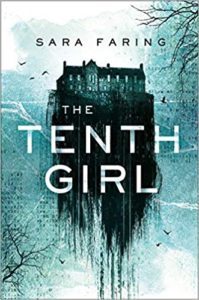 The Tenth Girl by Sara Faring (9/24)
The Tenth Girl by Sara Faring (9/24)A haunted Argentinian mansion.
A family curse.
A twist you’ll never see coming.
Welcome to Vaccaro School.
Simmering in Patagonian myth, The Tenth Girl is a gothic psychological thriller with a haunting twist.
At the very southern tip of South America looms an isolated finishing school. Legend has it that the land will curse those who settle there. But for Mavi―a bold Buenos Aires native fleeing the military regime that took her mother―it offers an escape to a new life as a young teacher to Argentina’s elite girls.
Mavi tries to embrace the strangeness of the imposing house―despite warnings not to roam at night, threats from an enigmatic young man, and rumors of mysterious Others. But one of Mavi’s ten students is missing, and when students and teachers alike begin to behave as if possessed, the forces haunting this unholy cliff will no longer be ignored… and one of these spirits holds a secret that could unravel Mavi’s existence.
 *There Will Come A Darkness by Katy Rose Poole (9/3)
*There Will Come A Darkness by Katy Rose Poole (9/3)
The Age of Darkness approaches.
Five lives stand in its way.
Who will stop it . . . or unleash it?
For generations, the Seven Prophets guided humanity. Using their visions of the future, they ended wars and united nations―until the day, one hundred years ago, when the Prophets disappeared.
All they left behind was one final, secret prophecy, foretelling an Age of Darkness and the birth of a new Prophet who could be the world’s salvation . . . or the cause of its destruction. With chaos on the horizon, five souls are set on a collision course:
A prince exiled from his kingdom.
A ruthless killer known as the Pale Hand.
A once-faithful leader torn between his duty and his heart.
A reckless gambler with the power to find anything or anyone.
And a dying girl on the verge of giving up.
One of them―or all of them―could break the world. Will they be savior or destroyer? Perfect for fans of Throne of Glass, Children of Blood and Bone, and An Ember in the Ashes.
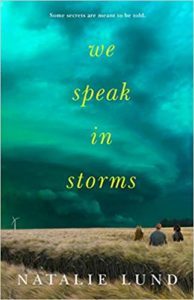 We Speak In Storms by Natalie Lund (9/3)
We Speak In Storms by Natalie Lund (9/3)It’s been more than 50 years since a tornado tore through a drive-in movie theater in tiny Mercer, Illinois, leaving dozens of teens — a whole generation of Mercerites — dead in its wake. So when another tornado touches down in the exact same spot on the anniversary of this small-town tragedy, the town is shaken. For Brenna Ortiz, Joshua Calloway, and Callie Keller, the apprehension is more than just a feeling. Though they seem to share nothing more than a struggle to belong, the teens’ paths continue to intersect, bringing them together when they least expect it, and perhaps, when they need it most. Both the living and the dead have secrets and unresolved problems, but they may be able to find peace and move forward–if only they work together.
A beautifully told, haunting yet hopeful novel about pushing past the pain, facing the world, and finding yourself.
September 19, 2019
This Week at Book Riot
Over on Book Riot this week…
Read your way into some spooky YA ghost books.
Speaking of spooky, if you need some horror bookends, I have you covered.
There’s a new episode of Hey YA this week, too. Eric and I dig into author writing duos, as well as highlight some of the fall YA books you might miss.
I was also a guest on the SSR Podcast this week. Alli and I reread Homecoming by Cynthia Voigt, which I really hated as a young reader. Turns out, that feeling remains — but Alli’s may have changed a bit from being a fan to being less of a fan. You can tune into the discussion here (link is to Spotify, but hit any podcatcher of your choice!).
September 17, 2019
Graphic Novel Roundup
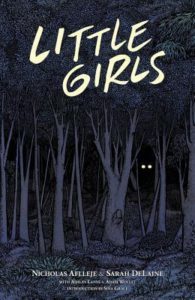 Little Girls by Nicholas Aflleje and Sarah DeLaine
Little Girls by Nicholas Aflleje and Sarah DeLaineI mentioned looking forward to this one after picking it up at TLA, but it was kind of a mess. The basic storyline is that there is a monster attacking a town in Ethiopia, killing people and animals. Two girls – one white and new to Ethiopia, one black and born there – decide to investigate it on their own. The synopsis promised some Ethiopian folklore, which manifests here in the monster called Kerit, but it was pretty difficult to decipher. I found it hard to follow the story, even on repeated reads. I’m still not entirely sure what happened, and even less sure about why, and it doesn’t seem intentional. It’s definitely not successful in delivering a traditional story (or really, a twist on a traditional story) to readers who are ignorant of it, but it doesn’t seem seem like it would be that interesting to readers who do know something about the monster already, either. This has the kernel of a good story, but the execution is a miss.
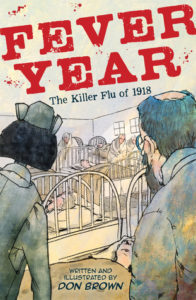 Fever Year: The Killer Flu of 1918 by Don Brown
Fever Year: The Killer Flu of 1918 by Don BrownDon Brown does a really good job of distilling complicated historical events into the graphic novel format. He includes first-person accounts, adding that level of detail that really personalizes something that may at first seem remote. He manages to keep the length in check, too, so the books never seem intimidating. I’m always impressed by how much information he packs into the slim volumes. His newest, Fever Year, is no different. While his book comes a year after the huge wave of books about the flu pandemic (including Albert Marrin’s excellent prose account Very, Very, Very Dreadful), it shouldn’t be overlooked – his signature artistic style adds a depth of emotion to the tragedy that is difficult to achieve in another non-graphic format. As usual, his facts are on point and he helps readers see how something like this – an event they may not have even heard about before – reverberates today.
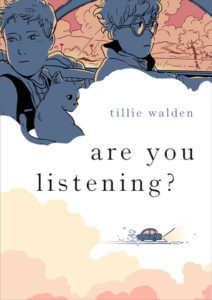 Are You Listening? by Tillie Walden
Are You Listening? by Tillie WaldenThis is Tillie Walden’s third graphic novel, but it’s the first one of hers I’ve read. Set in West Texas, it’s a story grounded in realism that slowly turns more and more fantasy as it goes on – much like a drive through the wide open spaces and mountains of West Texas itself. I have a soft spot for that part of the world, having driven through it alone a few times myself. It’s got a unique kind of beauty that I haven’t seen anywhere else, and it’s the perfect setting for Walden’s novel about two lost souls – a teenage girl running away from something terrible that happened at home, and a slightly older woman running from her own different demons. They fall in together for a while, eventually deciding to head to the (fictional) town of West to bring home a cat they rescued on the side of the road. But strange things start happening: the landscape seems to shift the closer they get, and dangerous people seem to be following them, looking for the cat. Walden’s art is great at showing the disruption of the landscape, which serves as a metaphor for the two young women’s respective traumas and how they’ve disrupted their lives. It’s an artistic and storytelling choice that feels perfect for West Texas. Walden treats her subjects with care. Her characters are prickly (understandably so), hurting, and in need of the friendship each can offer. The dash of magic is a great hook and deepens the story. This is an introspective novel for thoughtful teens. Plus, Walden gets bonus points for one of the two female leads being a car mechanic.
September 15, 2019
YA Book Title Trend: Full Names
It began innocently.
A full name here, a full name there.
But in the year 2017, something happened.
It continued in 2018.
And in 2019? 2020? It hit fever pitch: the full name on YA book titles.
Full names have always been part of book titles. They’ve also always been part of the YA book title landscape — not included above include Staying Fat for Sarah Byrnes and Here’s To You, Rachel Robinson, among others. But until 2017, it was only a few titles per year making use of a full character’s name. Since 2017, it’s exploded into a trend in titles that deserves a little recognition and a little discussion.
Full names on YA titles is a trend I am so into. It’s really a way to differentiate book titles, as after years of titles featuring “Girl” or “Girls,” “Noun of Noun and Noun,” or the single word title. Certainly, it’s easy for all of them to blend together. But, they also stand apart because those names are unique.
Something that makes full name titles special is the moment of recognition that readers may have with them, especially as we’re finally seeing YA books that better represent the inclusive world we live in. A reader browsing a book shelf and spotting a name that looks like their own is powerful. And that’s possible — Hispanic surnames, as well as Asian surnames (from all across the continent, East and West) — are right there for readers to see and connect with immediately.
There’s also a feeling of epic storytelling that comes along with a character’s full name in the title. Tirzah Price brought this up during an episode of Hey YA where we talked about this trend, and there’s a lot here to chew on. Since full names have been part of literary title history (Robinson Crusoe, Moll Flanders, A History of Tom Jones, Jane Eyre, The Picture of Dorian Gray, Anna Karenina, and even up to more modern classics like Harry Potter), using it for a book title infuses the sense of history and legacy before the reader even opens the cover. That more diverse names is especially noteworthy here, as the literary world becomes more inclusive and allows characters to be part of this history while also questioning why they haven’t been part of the history all along.
Though the representation here isn’t huge, there are a handful of YA titles, particularly in the last three years, that invoke the full name of a well-known figure. The Odds of Loving Grover Cleveland, not pictured above, is one example, as are Dear Rachel Maddow and Jack Kerouac Is Dead To Me. Worth noting that Grover Cleveland is like the president, but not the actual president, whereas for Jack Kerouac and Rachel Maddow do refer to the actual well-known people.
Maybe one of the most interesting aspects of this trend, though, is when the titular character isn’t the main character. Laura Dean Keeps Breaking Up With Me is one example; The Summer of Jordi Perez and Tyler Johnson Was Here are two more examples. The name sparks connection or intrigue with the reader, but the twist in that not being the main character adds an additional layer.
2020 has a pile more full name YA book titles hitting shelves that aren’t included here, as this trend doesn’t seem like it will be dying down any time soon. A book display of these titles, both old and new, would be eye-catching and engaging. Liz G, who tweets at CosLibrarian, did one in her library and it’s hard not to love:
"Hello my name is In the Title" display, thanks Kelly and @TirzahPrice and Hey YA! pic.twitter.com/dolJ9xGeT2
— Go
September 12, 2019
This Week at Book Riot
Over on Book Riot this week…
“Literature Locked Up” seeks to bring attention to prison book bans.
Rad space bookends for your shelves.
Put these YA paperbacks on your fall TBR.
It’s my week to cohost “All The Books,” so I raved about new books by Renée Watson, Jenni Hendriks and Ted Caplan, and more you can pick up right now. Tune in!
September 10, 2019
Booklist: Teen Chefs
I’m currently listening to Elizabeth Acevedo’s second novel, With the Fire on High, about a teen named Emoni who has a natural talent for cooking and dreams of working at (or running!) a restaurant some day. Acevedo narrates it herself, and she is so good at it; I highly recommend the audiobook. Her writing is a cut above pretty much anyone else writing today, and her voice elevates the book even further. It got me to thinking – what are some other books out there about teens who love to cook, where cooking and the love of food form a central part of the narrative? Turns out, there are quite a few. It would make a fun display (and would definitely make you hungry).
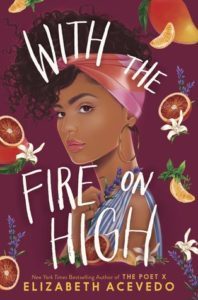 With the Fire on High by Elizabeth Acevedo
With the Fire on High by Elizabeth AcevedoWith her daughter to care for and her abuela to help support, high school senior Emoni Santiago has to make the tough decisions, and do what must be done. The one place she can let her responsibilities go is in the kitchen, where she adds a little something magical to everything she cooks, turning her food into straight-up goodness. Still, she knows she doesn’t have enough time for her school’s new culinary arts class, doesn’t have the money for the class’s trip to Spain — and shouldn’t still be dreaming of someday working in a real kitchen. But even with all the rules she has for her life — and all the rules everyone expects her to play by — once Emoni starts cooking, her only real choice is to let her talent break free.
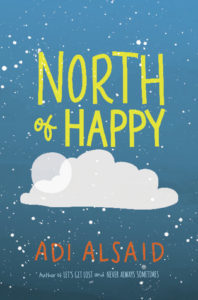 North of Happy by Adi Alsaid
North of Happy by Adi AlsaidCarlos Portillo has always led a privileged and sheltered life. A dual citizen of Mexico and the US, he lives in Mexico City with his wealthy family, where he attends an elite international school. Always a rule follower and a parent pleaser, Carlos is more than happy to tread the well-worn path in front of him. He has always loved food and cooking, but his parents see it as just a hobby.
When his older brother, Felix—who has dropped out of college to live a life of travel—is tragically killed, Carlos begins hearing his brother’s voice, giving him advice and pushing him to rebel against his father’s plan for him. Worrying about his mental health, but knowing the voice is right, Carlos runs away to the United States and manages to secure a job with his favorite celebrity chef. As he works to improve his skills in the kitchen and pursue his dream, he begins to fall for his boss’s daughter—a fact that could end his career before it begins. Finally living for himself, Carlos must decide what’s most important to him and where his true path really lies.
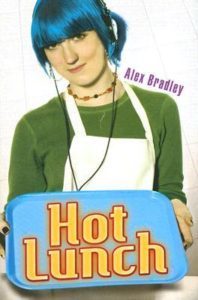 Hot Lunch by Alex Bradley
Hot Lunch by Alex BradleyMolly Ollinger can’t stand perky Cassie Birchmeyer. When they are forced to collaborate on a school project, their bickering escalates into a food fight in the Sunshine Day School cafeteria. But because Sunshine Day isn’t your average high school, the girls’ punishment isn’t detention it’s to work in the cafeteria as lunch ladies. Ewww. They will have to cook up a way to get along in order to get themselves out of the kitchen. Seasoned with hilarious original songs, slams on traditional school-lunch menus, not to mention downright tasty recipes, Hot Lunch is the best thing to hit school lunch since Tater Tots.
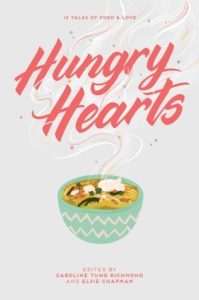 Hungry Hearts: 13 Tales of Food and Love edited by Elsie Chapman
Hungry Hearts: 13 Tales of Food and Love edited by Elsie ChapmanFrom some of your favorite bestselling and critically acclaimed authors—including Sandhya Menon, Anna-Marie McLemore, and Rin Chupeco—comes a collection of interconnected short stories that explore the intersection of family, culture, and food in the lives of thirteen teens.
A shy teenager attempts to express how she really feels through the confections she makes at her family’s pasteleria. A tourist from Montenegro desperately seeks a magic soup dumpling that could cure his fear of death. An aspiring chef realizes that butter and soul are the key ingredients to win a cooking competition that could win him the money to save his mother’s life.
Welcome to Hungry Hearts Row, where the answers to most of life’s hard questions are kneaded, rolled, baked. Where a typical greeting is, “Have you had anything to eat?” Where magic and food and love are sometimes one and the same.
Told in interconnected short stories, Hungry Hearts explores the many meanings food can take on beyond mere nourishment. It can symbolize love and despair, family and culture, belonging and home.
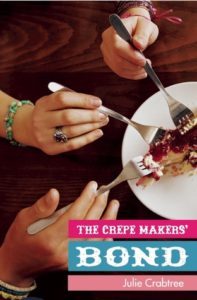 The Crepe Makers’ Bond by Julie Crabtree
The Crepe Makers’ Bond by Julie CrabtreeAriel is the head chef in her family kitchen. Cucumber salads, fettuccine carbonara, fish tacos, and peanut butter pie are just a few of the dishes she crafts when she’s feeling frustrated by the world. And it’s turning into a frustrating year. Ariel, Nicki, and Mattie have been inseparable friends since they were little kids, but now Mattie’s mom has decided to move away. It’s the girls’ last year in middle school, and they can’t fathom being separated. The friends concoct a plan that will keep Mattie in the Bay area — she’ll move in with Ariel and her family. But before you can say “bff,” the party is over. Everything Mattie does gets on Ariel’s nerves, and it’s not long before the girls are avoiding each other. This was supposed to be their best year ever, but some painful lessons are threatening to tear their friendship apart. Can the girls scramble to make things right before the bond crumbles?
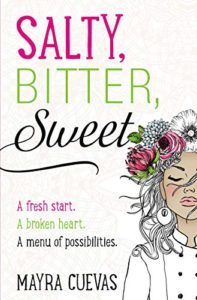 Salty, Bitter, Sweet by Mayra Cuevas (forthcoming March 20, 2020)
Salty, Bitter, Sweet by Mayra Cuevas (forthcoming March 20, 2020)Seventeen-year-old aspiring chef Isabella Fields’ family life has fallen apart after the death of her Cuban abuela and the divorce of her parents. She moves in with her dad and his new wife in France, where Isabella feels like an outsider in her father’s new life, studiously avoiding the awkward, “Why did you cheat on Mom?” conversation.
The upside of Isabella’s world being turned upside down? Her father’s house is located only 30 minutes away from the restaurant of world-famous Chef Pascal Grattard, who runs a prestigious and competitive international kitchen apprenticeship. The prize job at Chef Grattard’s renowned restaurant also represents a transformative opportunity for Isabella, who is desperate to get her life back in order.
But how can Isabella expect to hold it together when she’s at the bottom of her class at the apprenticeship, her new stepmom is pregnant, she misses her abuela dearly, and a mysterious new guy and his albino dog fall into her life?
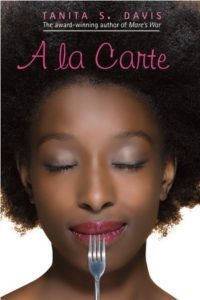 A la Carte by Tanita S. Davis
A la Carte by Tanita S. DavisSeventeen year old Lainey dreams of becoming a world famous chef one day and maybe even having her own cooking show. (Do you know how many African American female chefs there aren’t? And how many vegetarian chefs have their own shows? The field is wide open for stardom!) But when her best friend—and secret crush—suddenly leaves town, Lainey finds herself alone in the kitchen. With a little help from Saint Julia (Child, of course), Lainey finds solace in her cooking as she comes to terms with the past and begins a new recipe for the future.
Peppered with recipes from Lainey’s notebooks, this delicious debut novel finishes the same way one feels finishing a good meal—satiated, content, and hopeful.
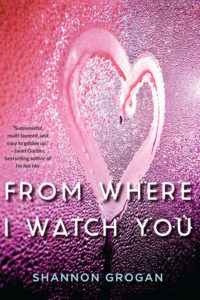 From Where I Watch You by Shannon Grogan
From Where I Watch You by Shannon GroganSixteen-year-old Kara McKinley is about to realize her dream of becoming a professional baker. Beautifully designed and piped, her cookies are masterpieces, but also her ticket out of rainy Seattle—if she wins the upcoming national baking competition and its scholarship prize to culinary school in California. Kara can no longer stand the home where her family lived, laughed, and ultimately imploded after her mean-spirited big sister Kellen died in a drowning accident. Kara’s dad has since fled, and her mom has turned from a high-powered attorney into a nutty holy-rolling Christian fundamentalist peddling “Soul Soup” in the family café. All Kara has left are memories of better times.
But the past holds many secrets, and they come to light as Kara faces a secret terror. Someone is leaving her handwritten notes. Someone who knows exactly where she is and what’s she’s doing. As they lead her to piece together the events that preceded Kellen’s terrible, life-changing betrayal years before, she starts to catch glimpses of her dead sister: an unwelcome ghost in filthy Ugg boots. If Kara doesn’t figure out who her stalker is, and soon, she could lose everything. Her chance of escape. The boy she’s beginning to love and trust. Even her life.
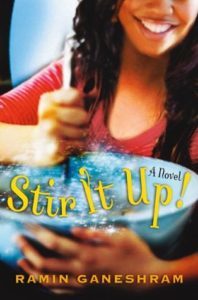 Stir it Up by Ramin Ganeshram
Stir it Up by Ramin GaneshramA Trinidadian-American girl’s dream is challenged by her family.
Thirteen-year-old Anjali’s life is rich with the smell of curry from her parents’ roti shop and an absolute passion for food. More than anything, Anjali wants to be a chef who competes on a kids’ cooking reality TV show. But Anjali must keep her wish a secret from her family, who thinks Anjali’s passions are beneath her. Thank goodness for Deema, Anjali’s grandmother, whose insight and love can push past even the oldest family beliefs. Woven with recipes that cook up emotions and actual culinary recipes that make food, this novel is as delicious as it is satisfying.
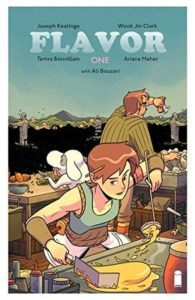 Flavor by Joseph Keatinge and Wook Jin Clark
Flavor by Joseph Keatinge and Wook Jin ClarkWithin a strange walled city, an unlicensed chef discovers a mystery that threatens to end it all. Join Joseph Keatinge (Glory, Shutter) and Wook Jin Clark (Adventure Time: The Flip Side) on this culinary epic adventure—Flavor—where chefs are the ultimate celebrity and food is the most valued commodity. The high-stakes competition of Hunger Games collides with the lush, Miyazaki-esque worldbuilding in this delectable new ongoing series featuring culinary consulting and bonus content by Ali Bouzari, renowned food scientist and author of the IACP Award-winning cookbook Ingredient: Unveiling the Essential Elements of Food.
 The Secret Ingredient by Stewart Lewis
The Secret Ingredient by Stewart LewisOlivia doesn’t believe in psychics. But the summer before her senior year of high school, she meets one in an elevator. This summer will be pivotal, the psychic warns. Please remember—all your choices are connected.
Olivia loves her life in Silverlake, Los Angeles, but lately, something’s been missing. And after getting this strange advice, her world begins to change. A new job leads Olivia to a gorgeous, mysterious boy named Theo. And as Olivia cooks the recipes from a vintage cookbook she stumbles upon, she begins to wonder if the mother she’s never known might be the secret ingredient she’s been lacking. But sometimes the things we search for are the things we’ve had all along.
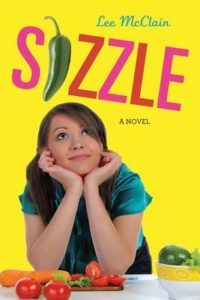 Sizzle by Lee McClain
Sizzle by Lee McClainLinda Delgado has the best nose in all of Arizona — for cooking, that is. She may be only fourteen, but Linda loves making fresh Mexican food with her aunt Elba and blogging about food with her best friend, Julia.
But after Aunt Elba suffers a ministroke, Linda is catapulted across the country and into a whole new life. In Pittsburgh, living with bossy Aunt Pat and her seven kids, Linda feels completely out of place. Aunt Pat wants Linda’s help with Angel, a young foster child in the family who speaks only Spanish, but he seems impossible. And Linda’s cousin Chloe treats her like a total intruder. Worst of all, Aunt Pat is a local celebrity with her own TV show, Cooking from Cans — and she won’t let Linda in the kitchen. Linda might go loco if she doesn’t get some fresh food — like now.
Finally Linda gets her chance to sizzle — with a cooking project at school. It’s an added bonus that cute-guy-with-a-secret Dino Moretti (who even smells delicious) is in her group. But when jealous Chloe joins the group, Linda’s new life heats up fast. In the end, it’s up to Linda to decide what kind of cook — and person — she truly wants to be.
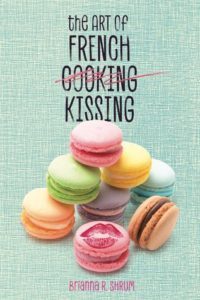 The Art of French Kissing by Brianna R. Shrum
The Art of French Kissing by Brianna R. ShrumSeventeen-year-old Carter Lane has wanted to be a chef since she was old enough to ignore her mom’s warnings to stay away from the hot stove. And now she has the chance of a lifetime: a prestigious scholarship competition in Savannah, where students compete all summer in Chopped style challenges for a full-ride to one of the best culinary schools in the country. The only impossible challenge ingredient in her basket: Reid Yamada.
After Reid, her cute but unbearably cocky opponent, goes out of his way to screw her over on day one, Carter vows revenge, and soon they’re involved in a full-fledged culinary war. Just as the tension between them reaches its boiling point, Carter and Reid are forced to work together if they want to win, and Carter begins to wonder if Reid’s constant presence in her brain is about more than rivalry. And if maybe her desire to smack his mouth doesn’t necessarily cancel out her desire to kiss it.
 Love a la Mode by Stephanie Kate Strohm
Love a la Mode by Stephanie Kate StrohmRosie Radeke firmly believes that happiness can be found at the bottom of a mixing bowl. But she never expected that she, a random nobody from East Liberty, Ohio, would be accepted to celebrity chef Denis Laurent’s school in Paris, the most prestigious cooking program for teens in the entire world. Life in Paris, however, isn’t all cream puffs and crepes. Faced with a challenging curriculum and a nightmare professor, Rosie begins to doubt her dishes.
Henry Yi grew up in his dad’s restaurant in Chicago, and his lifelong love affair with food landed him a coveted spot in Chef Laurent’s school. He quickly connects with Rosie, but academic pressure from home and his jealousy over Rosie’s growing friendship with gorgeous bad-boy baker Bodie Tal makes Henry lash out and push his dream girl away.
Desperate to prove themselves, Rosie and Henry cook like never before while sparks fly between them. But as they reach their breaking points, they wonder whether they have what it takes to become real chefs.
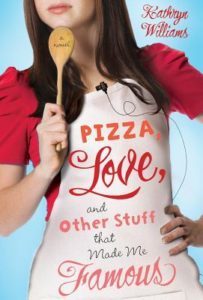 Pizza, Love, and Other Stuff That Made Me Famous by Kathryn Williams
Pizza, Love, and Other Stuff That Made Me Famous by Kathryn WilliamsCan a spot on a teen reality show really lead to a scholarship at an elite cooking school AND a summer romance?
Sixteen-year-old Sophie Nicolaides was practically raised in the kitchen of her family’s Italian-Greek restaurant, Taverna Ristorante. When her best friend, Alex, tries to convince her to audition for a new reality show, Teen Test Kitchen, Sophie is reluctant. But the prize includes a full scholarship to one of America’s finest culinary schools and a summer in Napa, California, not to mention fame.
Once on-set, Sophie immediately finds herself in the thick of the drama—including a secret burn book, cutthroat celebrity judges, and a very cute French chef. Sophie must figure out a way to survive all the heat and still stay true to herself. A terrific YA offering—fresh, fun, and sprinkled with romance.
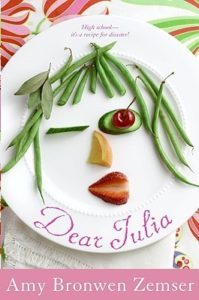 Dear Julia by Amy Bronwen Zemser
Dear Julia by Amy Bronwen ZemserElaine Hamilton has never wanted to be the center of attention. She’d like nothing more than to cook quietly in her kitchen, mastering French cooking with the recipes of the great Julia Child. So how did she end up with cameras zooming in on her and a crowd cheering her on? Well, it involves . . .
an eccentric best friend named after a font, five lively brothers constantly asking, “What’s for dinner?”, a rotten fig and a weakness, a feminist congresswoman mother, a yoga-practicing father, a chest full of unsent letters, and many, many roast ducks.
Delicious. Just delicious.
September 8, 2019
The “Girl” Is Still In The Title
Back in March 2017, I did a big roundup of YA books featuring the word “girl” or “girls” in the title. I thought the trend was slowing down by that point but, as it turns out, two and a half years later, the trend continues strong. It’s a trend I wasn’t wild about then, and I still hold the same reservations about it. When you look at the titles in a list like this — without the author and without covers — they all blend into one another. It makes doing reader advisory, as well as simply memory recall of a book title, extremely challenging. Imagine if this list also included adult titles (where the trend is still legion, too).
My parameters for this list are straight forward: I’m using titles from 2018, 2019, and what’s been announced of 2020 so far. I know this will miss some of the later 2017 titles in YA that came out after I made the initial list. Titles are pulled from Goodreads, using “Girl” and “Girls” in the YA book title that doesn’t refer to a specific girl named in the title (the example I used previously was Gabi, A Girl in Pieces doesn’t count but Girls Made of Snow and Ice does count).
Girl/Girls in the title are a reminder of how girls are objects, rathe than fully-realized beings in and of themself. It’s interesting to contrast this continuing title trend with a super refreshing trend I’ll write about next week: the full name in the title.
As I said before, in isolation, these titles aren’t a big deal. When seen in a list like this, though, it’s more than worth a pause.
2018:
A Girl Like That
Girl Made of Stars
Gunslinger Girl
Girls of Paper and Fire
Undead Girl Gang
Fat Girl On A Plane
Hullmetal Girls
Stone Girl
The Loneliest Girl In The Universe
Not The Girls You’re Looking For
Sawkill Girls
The Disturbed Girl’s Dictionary
Girl At The Grave
Girls On The Line
Pretty Dead Girls
Valley Girls
The Handsome Girl and Her Beautiful Boy
The Accidental Bad Girl
The Girl You Thought I Was
Paper Girl
The Girl and the Grove
2019:
The Girl King
Girls With Sharp Sticks
The Girl The Sea Gave Back
The Downstairs Girl
Wilder Girls
Hot Dog Girl
Hello Girls
Girls On The Verge
The Boy and Girl Who Broke The World
The Tenth Girl
A Good Girl’s Guide to Murder
Rebel Girls
What Every Girl Should Know
The Good Luck Girls
We Are The Perfect Girl
Orpheus Girl
All-American Muslim Girl
War Girls
The Girl Who Came Out Of The Woods
Ordinary Girls
Girls Like Us
Resurrection Girls
Girl Gone Viral
Fake Plastic Girl
Chicken Girl
2020:
Elysium Girls
Throw Like A Girl
Black Girl Unlimited
Throwaway Girl
The Blackbird Girl
Almost American Girl
Six Angry Girls
A Cuban Girl’s Guide to Sweaters and Stars
Girls Save The World In This One
The Flutter-By Girl
Girl Crushed
Brown Girl Ghosted
Pretty Funny for a Girl
The October Girl
The Girl In The White Van
September 5, 2019
This Week at Book Riot
Over on Book Riot this week…
The last four months, I worked on an episode of Annotated, our podcast that could be called “This American Life” or “RadioLab” for books. This is a deep dive into the question of why it is the Baby-Sitters Club books endure. I hope you love it as much as I do.
I also pulled together a companion piece to the podcast which you can enjoy that’s a deep dive into why The Baby-Sitters Club endures.
There’s a new episode of Hey YA, wherein Eric and I dig into YA books we had read when we went to college and then share our fall TBR piles.



